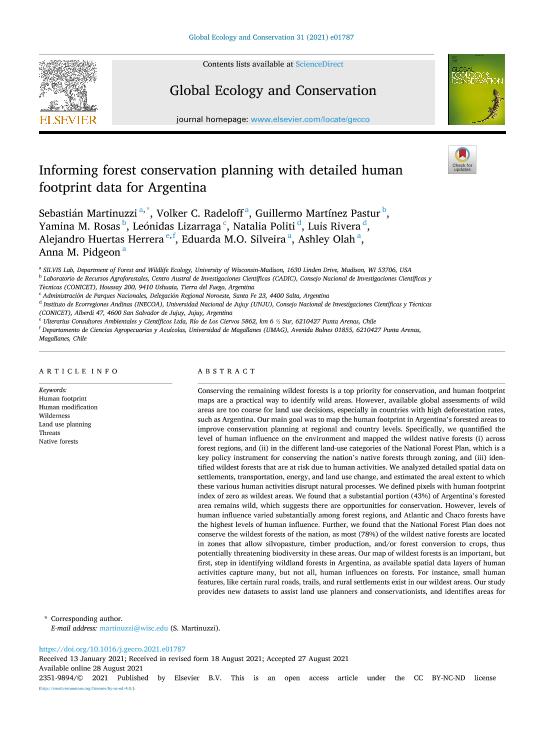Artículo
Informing forest conservation planning with detailed human footprint data for Argentina
Martinuzzi, Sebastián; Radeloff, Volker; Martínez Pastur, Guillermo José ; Rosas, Yamina Micaela
; Rosas, Yamina Micaela ; Lizarraga, Leónidas; Politi, Natalia
; Lizarraga, Leónidas; Politi, Natalia ; Rivera, Luis Osvaldo
; Rivera, Luis Osvaldo ; Huertas Herrera, Alejandro
; Huertas Herrera, Alejandro ; Silveira, Eduarda; Olah, Ashley; Pidgeon, Anna Michle
; Silveira, Eduarda; Olah, Ashley; Pidgeon, Anna Michle
 ; Rosas, Yamina Micaela
; Rosas, Yamina Micaela ; Lizarraga, Leónidas; Politi, Natalia
; Lizarraga, Leónidas; Politi, Natalia ; Rivera, Luis Osvaldo
; Rivera, Luis Osvaldo ; Huertas Herrera, Alejandro
; Huertas Herrera, Alejandro ; Silveira, Eduarda; Olah, Ashley; Pidgeon, Anna Michle
; Silveira, Eduarda; Olah, Ashley; Pidgeon, Anna Michle
Fecha de publicación:
11/2021
Editorial:
Elsevier
Revista:
Global Ecology and Conservation
ISSN:
2351-9894
Idioma:
Inglés
Tipo de recurso:
Artículo publicado
Clasificación temática:
Resumen
Conserving the remaining wildest forests is a top priority for conservation, and human footprint maps are a practical way to identify wild areas. However, available global assessments of wild areas are too coarse for land use decisions, especially in countries with high deforestation rates, such as Argentina. Our main goal was to map the human footprint in Argentina's forested areas to improve conservation planning at regional and country levels. Specifically, we quantified the level of human influence on the environment and mapped the wildest native forests (i) across forest regions, and (ii) in the different land-use categories of the National Forest Plan, which is a key policy instrument for conserving the nation's native forests through zoning, and (iii) identified wildest forests that are at risk due to human activities. We analyzed detailed spatial data on settlements, transportation, energy, and land use change, and estimated the areal extent to which these various human activities disrupt natural processes. We defined pixels with human footprint index of zero as wildest areas. We found that a substantial portion (43%) of Argentina's forested area remains wild, which suggests there are opportunities for conservation. However, levels of human influence varied substantially among forest regions, and Atlantic and Chaco forests have the highest levels of human influence. Further, we found that the National Forest Plan does not conserve the wildest forests of the nation, as most (78%) of the wildest native forests are located in zones that allow silvopasture, timber production, and/or forest conversion to crops, thus potentially threatening biodiversity in these areas. Our map of wildest forests is an important, but first, step in identifying wildland forests in Argentina, as available spatial data layers of human activities capture many, but not all, human influences on forests. For instance, small human features, like certain rural roads, trails, and rural settlements exist in our wildest areas. Our study provides new datasets to assist land use planners and conservationists, and identifies areas for conservation attention in Argentina. More broadly, our analyses highlight the value of detailed human footprint data to support conservation decisions in forest landscapes.
Archivos asociados
Licencia
Identificadores
Colecciones
Articulos(CADIC)
Articulos de CENTRO AUSTRAL DE INVESTIGACIONES CIENTIFICAS
Articulos de CENTRO AUSTRAL DE INVESTIGACIONES CIENTIFICAS
Articulos(INECOA)
Articulos de INSTITUTO DE ECORREGIONES ANDINAS
Articulos de INSTITUTO DE ECORREGIONES ANDINAS
Citación
Martinuzzi, Sebastián; Radeloff, Volker; Martínez Pastur, Guillermo José; Rosas, Yamina Micaela; Lizarraga, Leónidas; et al.; Informing forest conservation planning with detailed human footprint data for Argentina; Elsevier; Global Ecology and Conservation; 31; 11-2021; 1-14
Compartir
Altmétricas



